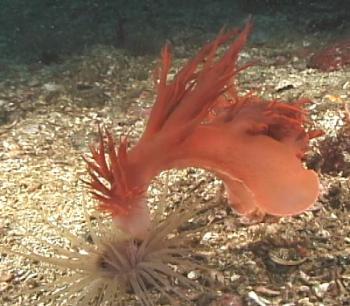Dendronotus iris question
December 19, 2000
From: Ray Izumi

I've been filming Dendronotus iris in British Columbia for several years now. Recently I came across a herd of them (is there a word for a gathering of nudibranchs?) actively feeding, something I had never witnessed even after hours of observation.
I noticed that the nudibranch seems to locate its prey (the burrowing anemone Pachycerianthus fimbriatus) by touch. Watching macro video of the "strike", I could see clearly that the oral tentacles seem to react strongly to the touch of the anemone's stinging tentacles by quickly withdrawing.
Conventional wisdom has it that Dendronotus iris ingests these stinging tentacles and passes them intact through its digestive system and then to its own cerata, where they act as a defense for the animal. Is it possible for this to occur and yet the nudibranch does not develop an immunity to the sting of the anemone? If so, what are the implications of this in regards to mating behavior, where two animals must come in close contact?
Attached is a specimen caught in flagrante delicto at Chup Point in Barkley Sound, British Columbia, in 40 feet of water on sandy bottom littered with Pachycerianthus fimbriatus, temperature 46F, 27 Nov. 2000.
Ray Izumi
izumirm@sprynet.com
Dear Ray,
Thanks for the photo and observations on Dendronotus iris. To answer your questions in sequence, I guess 'herd' is as good a collective noun as I have heard. it would fit many of them, especially Sea Hares, and I quite often use the term myself, though not officially.
On your question about them being stung by the anemones, nudibranchs that feed on stinging food are often stung and you can watch them often trying to avoid being stung. On the problem of nudibranchs with nematocysts in their cerata stinging each other, the answer is that the nematocysts are not released solely through physical contact. The nudibranch has to be alarmed before the cnidosacs release their stolen weapons. Presumably two nudibranchs of the same species in close contact would not be alarmed.
Now to the question about Dendronotus having nematocysts. There has been some confusion in the literature concerning the presence of branches of the gut in the 'gills' or 'cerata' of species of Dendronotus. Firstly there is no evidence to suggest that any species of Dendronotus has cnidosacs at the tip of its dorsal processes in which to store nematocysts. In fact there is no evidence that they store nematocysts from their prey anemones in any part of their body.
The second point concerns branches of the gut. In Dendronotus frondosus some authors reported that it had branches of the digestive gland in its dorsal processes and others said it didn't. What we now know is that there are branches of the gut in the dorsal processes of juveniles but not in adults. In Dendronotus iris there are branches of the gut in the rhinophore stalks and the first pair of dorsal processes but not in any of the other dorsal processes.
Why am I calling them 'dorsal processes'? Well they are clearly not cerata as found in aeolids. Perhaps 'gills' is a better name for them, but I know of no study to show they are important in respiration.
Hope that answers your questions.
Best wishes,
Bill Rudman.
Related messages
-
Dirona albolineata eggs?
From: Jackie Hildering, August 6, 2007 -
Dendronotus iris eggs?
From: Jackie Hildering & Glen Miller, July 7, 2007 -
Dendronotus iris from La Jolla, California
From: Regina McLendon, June 10, 2006 -
Dendronotus iris feeding behaviour
From: Dave Behrens, May 19, 2006 -
Dendronotus iris feeding behaviour
From: Phil Garner, May 19, 2006 -
Colour forms of Dendronotus iris
From: Stephanie Truhlar, May 18, 2006 -
Re: Dendronotus nanus rediscovered in California
From: Phil Garner, May 18, 2006 -
Nudibranch? from southern California
From: Lauri Hamilton, April 27, 2006 -
Dendronotus nanus rediscovered in California
From: Mark Chapman, August 11, 2005 -
Dendronotus nanus is variant of D. iris [1]
From: Ron Velarde, August 11, 2005 -
Dendronotus nanus is variant of D. iris [2]
From: Dave Behrens, August 11, 2005 -
Giant nudibranch attack from British Columbia
From: Marli Wakeling, June 29, 2005 -
Dendronotus iris in Monterey, CA
From: Sami Laine, February 9, 2003 -
Re: Swimming Nudibranchs
From: Marli Wakeling, November 4, 2002 -
Swimming nudibranchs
From: Peter & Kristen , November 2, 2002 -
Dendronotus iris - feeding movies
From: Clinton Bauder, September 6, 2001 -
Dendronotus iris from Monterey, California
From: Clinton Bauder , June 6, 2001
